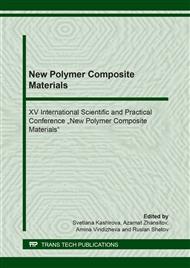[1]
Y.H. Kim, O.W. Webster, Water-soluble hyperbranched polyphenylene: «А unimolecular micelle», J. Am. Chem. Soc. 112 (1990) 4592-4593.
DOI: 10.1021/ja00167a094
Google Scholar
[2]
M. Jikei, H. Itoh, N. Yoshida, Y. Inai, T.Hayakawa, M.A. Kakimoto, Synthesis of hyperbranched poly(ether nitrile)s by one step polycondensation of an AB2 monomer, J. Polym. Sci. Part A Polym. Chem. 47 (2009) 5835-5844.
DOI: 10.1002/pola.23629
Google Scholar
[3]
C. Hong, C. Pan, Synthesis and characterization of hyperbranched polyacrylates in the presence of a tetrafunctional initiator with higher reactivity than monomer by self-condensing vinyl polymerization, Polymer 42 (2001) 9385-9381.
DOI: 10.1016/s0032-3861(01)00494-3
Google Scholar
[4]
R.K. Roy, S. Ramakrishnan, Сontrol of molecular weight and polydispersity of hyperbranched polymers using a reactive B3 core: a single-step route to orthogonally functionalizable hyperbranched polymers, Macromolecules 44 (2011) 8398-8406.
DOI: 10.1021/ma201817a
Google Scholar
[5]
Y. Ohta, Y. Kamijyo, S. Fujii, A. Yokoyama, T. Yokozawa, Synthesis and properties of a variety of well-defined hyperbranched N-alkyl and N-H polyamides by chain-growth condensation polymerization of AB2 monomers, Macromolecules 44 (2011) 5112–5122.
DOI: 10.1021/ma200980t
Google Scholar
[6]
Z. Zhou, Z. Jia, D. Yan, Kinetic analysis of AB2 polycondensation in the presence of multifunctional cores with various reactivities Polymer 53 (2012) 3386-3391.
DOI: 10.1016/j.polymer.2012.05.032
Google Scholar
[7]
C. Kuo-Chung, D. Trong-Ming, G. Wenjeng, C. Tsu-Hwang, Kinetic model of hyperbranched polymers formed by the polymerization of AB2 monomer with a substitution effect, Polymer 43 (2002) 6315-6322.
DOI: 10.1016/s0032-3861(02)00545-1
Google Scholar
[8]
C. Kuo-Chung, Y. W. Lee, Kinetic model of hyperbranched polymers formed in copolymerization of AB2 monomers and multifunctional core molecules with various reactivities Macromolecules 35 (2002) 5657–5664.
DOI: 10.1021/ma0118062
Google Scholar
[9]
V. I. Irzhak, Kinetics of formation of hyperbranched polymers, Russ. Chem. Rev. 77 (2008) 1079–1104.
DOI: 10.1070/rc2008v077n12abeh003891
Google Scholar
[10]
H. Galina, J.B. Lechowicz, K. Kaczmarski, Kinetic models of the polymerization of an AB2 monomer, Macromolecular Theory and Simulation. 10 (2001) 174-178.
DOI: 10.1002/1521-3919(20010301)10:3<174::aid-mats174>3.0.co;2-z
Google Scholar
[11]
V.O. Rodionov, V.V. Fokin, M.G. Finn Mechanism of the ligand-free CuI-catalyzed azide-alkyne cycloaddition reaction. Angew. Chem. Int. Ed. 44 (2005) 2596-2599.
DOI: 10.1002/anie.200461496
Google Scholar


